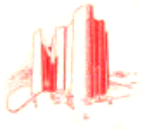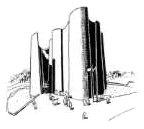|
-

- HALL OF SCIENCE
-
- In one big pavilion, 11 companies and organizations present displays devoted to recent and imminent advances in scientific knowledge - including the simulated meeting in orbit of two space vehicles. The building itself, a permanent structure, will become the New York Museum of Science and Technology.
-
- * Admission: free.
-
- A JOURNEY INTO SPACE. In the Great Hall, a supply vehicle appears to blast off from Earth, bound for a meeting with a space station in orbit 350 miles away - actually about 50 feet above the floor. This exhibit, resented by the Martin Marietta Corporation, heightens the impression of a trip into space with the use of motion pictures and authentic sound and lighting effects.
- HOW THE BRAIN WORKS. The process of sensory perception is traced through a human "brain" made of aluminum disks, 38 miles of wire and 30,000 blinking lights. The exhibit, prepared by The Upjohn Company, demonstrates the complex cerebral procedures involved in a simple decision to applaud the performance of a singer.
- THE WAY WE HEAR. The exhibit of the Hearing Aid Industry Conference, Inc. explains every aspect of hearing, including the social and physical problems of deafness and the efforts of science to solve them.
- CHEMICAL MAN. Abbott Laboratories shows a 15-minute film about the human body and its cellular structure. The film, projected on the floor of an egg-shaped auditorium, is complemented by colored models of the molecules of a cell.
- A COLOR CENTER. The world of color is depicted by the Interchemical Corporation in a number of displays, including a red, blue and green top that turns white as it spins, and moving objects that change color as they pass through different kinds of light.
- ATOMS FOR CHILDREN. In "Atmosville, U.S.A.," the U.S. Atomic Energy Commission presents an explanation of nuclear energy for children from seven to 14. The display contains exhibits such as a remote-controlled manipulator, designed for the handling of radioactive substances, which the youngsters may operate themselves. (No real radioactive materials are used, of course.)
- ¶ For adults, the AEC explains atomic energy and its value in research, agriculture and medicine. The displays include animated units, one of which lets the visitor make his own "atoms."
- THE CHEMISTRY OF OCEANS. Both audio and photographic material are used by the American Chemical Society to describe the techniques being developed to uncover the oceans' rich resources of chemicals and minerals.
- FLIGHT CONTROL. A model air terminal with moving planes and a control tower demonstrates some of the electronic devices that guide the landing of aircraft.
- THE WAR AGAINST CANCER. The exhibit of the American Cancer Society demonstrates in sound and pictures the importance of cancer research as exemplified by the story of a major lifesaving cancer detection test.
- THE DIAGNOSIS OF DISEASE. Animated models and diagrams in the display of the Ames Company show ow chemical and electronic detection help diagnose diabetes, gout and other diseases.
- THE CHEMISTRY OF COLOR. An exhibit presented by the General aniline and Film Corporation shows contributions made to organic chemistry by scientists working in dyestuff research.
-
|
|
|
|

- HALL OF SCIENCE
- .
-
- Eleven exhibitors display scientific advances ranging from disease control to travel in space.
This building, a permanent structure, will become the New York Museum of Science and Technology after the Fair closes.
A SPACE TRIP. In the Great Hall, a rendezvous in space is realistically simulated with special effects. At the climax, two full-scale spaceship models hover 50 feet in the air to exchange crews and supplies.
BIOLOGICAL WONDERS. Sensory perception is traced through a "brain" made of 38 miles of wire and 30,000 lights. The problems of deafness are explained, and a 15-minute film illustrates the body's cellular structure. Other exhibits illustrate cancer research and the electronic detection of diseases.
ATOMS FOR KIDS. In "Atomsville, U.S.A.," nuclear energy is explained for children. Among the exhibits is a remotely controlled manipulator which the youngsters may operate to handle "radioactive" materials. For adults, there are displays on nuclear energy in research, agriculture and medicine, and an exhibit on nuclear fallout and how to guard against its hazards.
COLOR AND CHEMISTRY. Displays demonstrate the changing nature of color, advances in dyestuff research, and techniques for tapping the sea's rich resources.
Exhibitors in the Hall of Science are Abbott Laboratories, the American Cancer Society, the American Chemical Society, the Ames Company, the General Aniline and Film Corporation, the Hearing Aid Industry Conference, the Interchemical Corporation, the Martin Marietta Corporation, the United States Office of Civil Defense, The Upjohn Company and the United States Atomic Energy Commission.
|
|
|
|